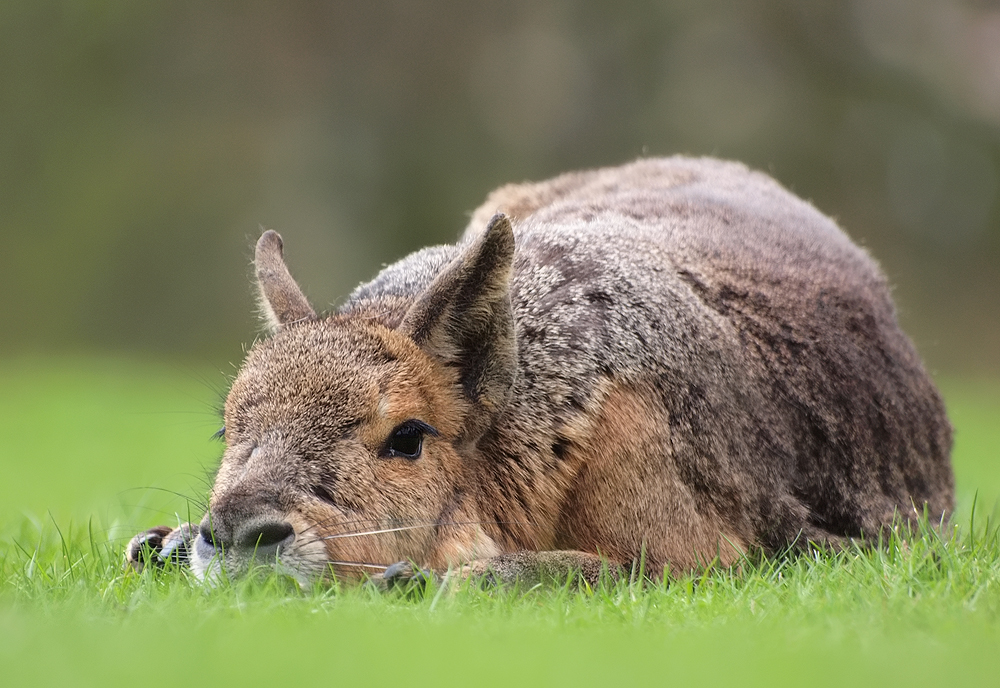
Guide to the Wildlife of Patagonia
Some of the largest and most unspoilt tracts of wilderness on earth, Patagonia's temperate rainforests, towering mountain ranges, grasslands, fjords, lake and rivers are home to more than 500 wildlife species, making it one of the most diverse and fauna-rich regions in South America. Birdwatchers, wildlife photographers and wildlife lovers alike come to this vast natural playground in the.

Mara, Patagonian Hare, Patagonian Cavy or Dillaby (Dolichotis patagonum
Patagonia is a geographical location spanning the southernmost region of South America. Shared by both Argentina and Chile, it has two coasts on the Pacific and Atlantic Oceans and is divided by the Andes Mountain Range. Patagonia got its name in 1520 from Ferdinand Magellan, the Portuguese explorer.

Patagonian haired armadillo (Chaetophractus villosus), Torres del Paine
No zoophile can resist the thrall of the unique wildlife of Patagonia. With over 500 animal species, the animal lover in you will be screaming in delight at the otherworldly species that only an environment as wild, harsh and untamed as Patagonia will create. Here you can find a cornucopia of flightless birds, mountain lions and cats, small fluffy mammals and those with natural armored plates.

Guide to the Wildlife of Patagonia
Marine Animals of Patagonia . The waters around Patagonia are home to an abundance of marine life. Along with the magnificent whales there are playful dolphins, sunbathing sea lions, enormous elephant seals and endangered marine otters.. Patagonia is home to over 460 species of birds, making a trip to Chile or Argentina an unforgettable.
.jpg)
The 6 Best Places to See Wildlife in Argentina — Sol Salute
Valdez Peninsula, a wedge of Patagonia that juts out into Argentina's Atlantic seaboard is probably the richest area for wildlife in South America outside th.

Gauchos, Patagonia, Chile Wildlife of Torres del Paine National park
Patagonia (Spanish pronunciation: [pataˈɣonja]) is a geographical region that encompasses the southern end of South America, governed by Argentina and Chile.The region comprises the southern section of the Andes Mountains with lakes, fjords, temperate rainforests, and glaciers in the west and deserts, tablelands and steppes to the east. Patagonia is bounded by the Pacific Ocean on the west.

Patagonia Animals A Wildlife Guide to Southern Chile & Argentina
Patagonia - Flora, Fauna, Ecosystems: The long, narrow strip of Patagonia's western border supports vegetation like that found in the adjacent cordillera, primarily deciduous and coniferous forests. The vast tableland region is divided into northern and southern zones, each of which has its own characteristic vegetation. The larger northern steppe zone extends south to about latitude 46° S.

Birds of Argentina Argentina, South america, Patagonia
In addition to it's famous pumas, penguins and whales, Patagonia has to an abundance of other wildlife. Home to the worlds smallest deer, over-sized rodents and endangered wild cats, there are incredible wildlife experiences on offer. Any animal lover will be in their element in this area of Chile and Argentina. Camelids Deer Small animals Cats.

Patagonia Animals A Wildlife Guide to Southern Chile & Argentina
Patagonian Gray Fox. One of the cutest animals in South America is the South American gray fox. The South American gray fox is a small fox-like canid, weighing 2.5 to 5.5 kilograms (5.5 to 12.0 lb), and measuring 65 to 110 cm (26 to 43 in) in length including a tail of 20 to 43 cm (8 to 17 in). The gray fox is one of the more common animals in.

7 Animals in Patagonia to Spot on tour EF Go Ahead Tours
Patagonia is a vast and rugged region in the far south of South America. Shared between Argentina and Chile, this sparsely populated territory may — at first glance — seem barren and bleak. But wildlife spotters flock to Patagonia in the hopes of seeing some of its most iconic and intriguing animals, including both land and marine mammals.

Guide to the Wildlife of Patagonia
These graceful animals have adapted to thrive in the diverse landscapes of Argentina, displaying their resilience in the face of harsh environments. The guanaco population in Chilean Patagonia, however, has experienced a worrisome decline of up to 75% in recent decades, primarily due to hunting. Recognizing the importance of conserving this.

Patagonia Animals A Wildlife Guide to Southern Chile & Argentina
Patagonian mara. The Patagonian mara ( Dolichotis patagonum) is a relatively large rodent in the mara genus Dolichotis. [3] It is also known as the Patagonian cavy or Patagonian hare. This herbivorous, somewhat rabbit -like animal is found in open and semiopen habitats in Argentina, including large parts of Patagonia.

10 Awesome Native Animals You Must See in Argentina
Birds present in Patagonia are mainly predatory and carrion species. Amongst these are the famous Andean Condor, the Caracara, Vultures, Hawks, Eagles and Falcons. The largest bird in the region, the Lesser Rhea, similar to ostriches and known as ñandu locally, are found throughout Patagonia. Other smaller birds occur throughout Patagonia.

Wildlife of Patagonia Chile and Argentina
There are plenty of animals you can see in Patagonia. In Torres del Paine National Park alone, there are 118 bird species and 26 mammal species. Some travelers come to see "Patagonia's Big Five", namely the puma, the guanaco, the huemul, the Andean condor and the Darwin's rhea.

10 Animals You Probably Didn’t Know Existed Top 10s
Orca. WHERE: Punta Norte, Península Valdés, Chubut province. When: March and April. While the orca, or killer whale, frequents Patagonia year-round, these marine mammals are particularly active.

Patagonia Animals A Wildlife Guide to Southern Chile & Argentina
Patagonia, semiarid scrub plateau that covers nearly all of the southern portion of mainland Argentina.With an area of about 260,000 square miles (673,000 square kilometres), it constitutes a vast area of steppe and desert that extends south from latitude 37° to 51° S. It is bounded, approximately, by the Patagonian Andes to the west, the Colorado River to the north (except where the region.